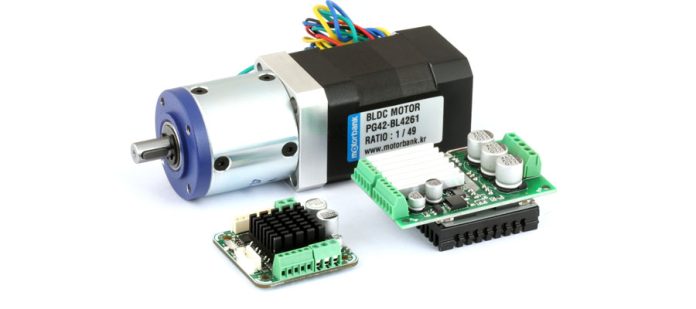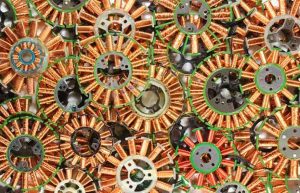The advantages and uses of brushless DC motors (BLDC)
BLDCs, or brushless DC motors, have a number of advantages over their traditional “brushed” counterparts. Brushless motors are used in drones, power tools, consumer goods, packaging equipment, appliances, medical applications, and more. In this post, we’ll explore the relative advantages and disadvantages of BLDC motors compared to other motor technologies. We’ll also learn where to see them in action and how you can put them to use.
What is a BLDC motor?
Brushless DC motors sequentially energize an arrangement of electromagnetic coils on a motor’s stator (stationary section) to produce a force on permanent magnets arranged on the motor’s rotor (rotating section). Stator coils must be energized in a specific pattern with varying electrical — and thus magnetic — directions by a specialized driver. BLDC motors operate significantly more efficiently than brushed DC motors, given the same loads and speeds.
Executing this pattern requires the driver to know the rotor’s position at any given time. BLDC motors feature closed-loop control, typically via a Hall effect sensor or by detecting back EMF. Rotational output can be controlled with a high degree of accuracy by varying the speed of the coil sequence. BLDC motors share some similarities with stepper motors, but BLDCs are optimized for high speed, while steppers, which use an open-loop setup, are optimized for accurate positioning.
Types of BLDC motor
Two main styles of the BLDC motor exist: inrunner and outrunner.
- Outrunner BLDCs have permanent magnets on the outer section that moves as it turns the output shaft. BLDCs typically have more torque for a given size than inrunners and operate at a lower speed. Electromagnets are arranged on the inner stator section. They don’t cool as well as their inrunner counterparts, and the housing doesn’t provide as much protection from the elements.
- Inrunner BLDCs arrange electromagnets inside a fixed outer housing, while permanent magnets are on the internal rotor. Inrunners typically spin faster than outrunners, producing lower torque at a given size. Inrunner motors have the advantage of better protection from the elements and better cooling since the electromagnet coils are attached directly to the external housing.
The electromagnetic sections of both the inrunner and outrunner remain stationary while the magnets turn. That’s different than on a traditional DC motor, where the magnets remain stationary (affixed to the housing) while the electromagnetic section rotates. The other fundamental difference is that instead of timing coil energization based on a Hall effect sensor or back EMF, brushed DC motors use physical brushes to transmit electricity in a “mechanically programmed” sequence.
The big advantage of brushed DC motors versus brushless DC motors is that they are inexpensive and easy to use; simply connect one up to DC power at the appropriate voltage. Disadvantages, however, include lower efficiency, brushes that wear out due to friction, and sparks. Brushed DC motors also have less output control when compared to BLDC motors. They have no built-in feedback, and varying voltage input is the only method for modifying the output RPM and torque.
Is a BLDC motor a stepper, AC motor, or something unique?
Brushless DC motors rotate in quick sequential steps, so it’s tempting to throw this rotational device into the stepper motor category. As noted earlier, the practical difference is that BLDCs are typically designed for high-speed operation, while steppers are set up for precision positioning. If you need a motor to turn at several thousand RPM, a BLDC is the proper choice versus a stepper.
At the same time, if you need a motor to accurately turn fractions of a revolution, back and forth, over and over, stepper motors can work very well. Consider that CNC routers and 3D printers frequently operate under stepper control for hours at a time while each step stays perfectly in sync. Servo motors, which use sensor feedback to determine how far a motor travels, can also be a good choice for precise positioning.
Given that BLDC motors combine elements of stepper and servo operation, one can rightly consider BLDCs to be an entirely unique system. With excellent speed performance and efficiency, integrated feedback, and low maintenance costs, BLDC motors are an attractive option for a variety of automation projects.
BLDC vs PMSM for AC power input
BLDC motors are direct current devices, but an alternating current analog is called a permanent magnet synchronous motor (PMSM). Instead of a controlled DC supply to each coil, this type of motor instead uses an AC input source with a variable frequency drive to control the motor speeds. PMSMs are typically more efficient and produce more torque than BLDC motors and are often employed in electric vehicles. While not the same thing as a BLDC motor, PMSMs are a good alternative in many situations.
BLCD control methods
With rotational information provided by dedicated sensors or back EMF, BLDC control can be implemented by one of three methods: trapezoidal, sinusoidal, and field-oriented control (FOC).
- Trapezoidal control is the simplest method for powering a BLDC, energizing each phase in sequence. Coils are energized in either a high or low state or can be left floating. While broadly applicable, this is often not as effective as using more advanced techniques and can produce audible noise.
- Sinusoidal control energizes each BLDC coil using variable duty-cycle PWM techniques to simulate analog outputs. This allows for a much smoother transition between states, using a lookup table to determine the correct signal. Coils are often energized in a saddle pattern, rather than a pure sinusoidal output.
- Field-oriented control (FOC) works similarly to variable-output sinusoidal control, but also takes the motor’s changing winding currents into account when calculating voltage inputs. FOC can produce constant torque and speeds with low acoustic noise and is the most efficient way to drive a BLDC motor.
BLDC motor applications
BLDC motor technologies are prominently used today in drone systems, where coordinating four or more rotors capable of high speeds, efficiency, and low maintenance is of utmost importance. We also see them increasingly integrated into power tools, though BLDC models will typically come with a significant price premium over their brushed counterparts. Appliances like washing machines and dryers include BLDC motors, as well as some fans and pumps.
Other applications include small cooling fans on PCs, which are usually powered by BLDC motors. Precisely spinning magnetic/optical media (hard drives and CD/DVD/Blu-ray players) also employ this technology. Broadly speaking, other applications include electric vehicles (including electric bikes), packaging equipment, and medical devices.
Getting started with brushless DC motors
Given their significant advantages, we will likely see increased usage of BLDC motor technology in the immediate future. Look for further use of the most advanced FOC methodologies for better motor efficiencies and power output, and the availability of ever-more-capable drivers.
Whether you have a pending project, or a potential future use case, there’s no better time to explore BLDC technology. To help get started, Arrow offers a variety of BLDC evaluation boards that ease design effort and shortened times to market.











